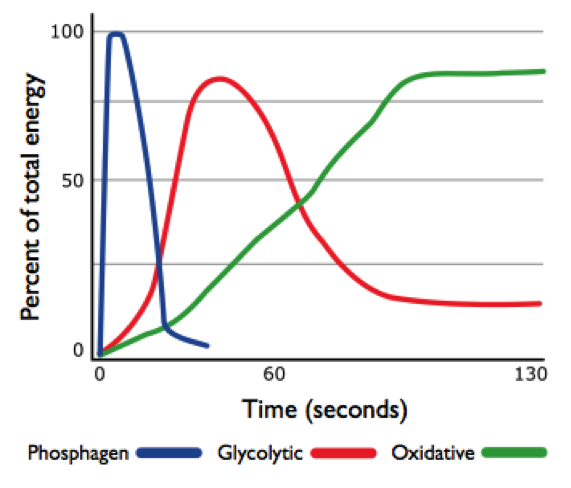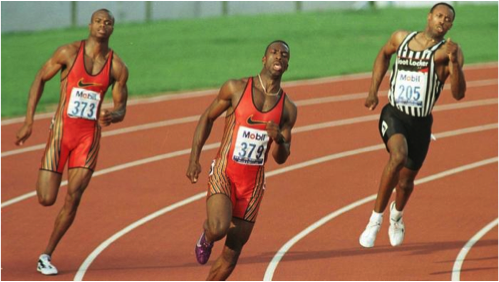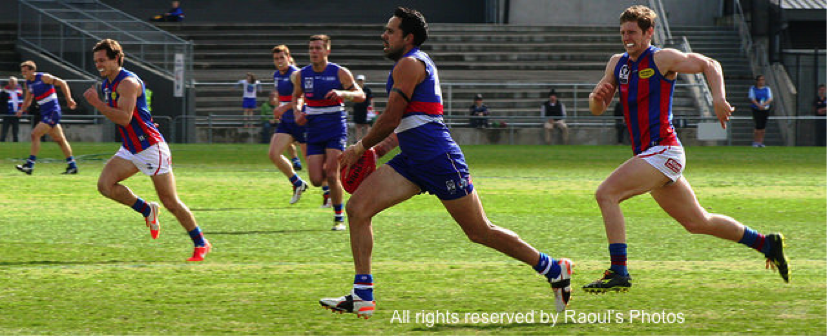The 3 Energy Systems – A quick Introduction
I will keep this as short and simple as possible, as this topic is one which could quickly become technical and long winded – and it doesn’t need to be. It is however, a topic that it is good to have a basic understanding of in order to know why certain forms of training are more effective for footy (or any activity for that matter) than others – and why training for different sports should be just that – different (if the energy system demands are different that is.) So lets have a quick look.
Your 3 energy systems are basically the means by which your body produces energy to power your various forms of movement. The graph below gives a visual comparison of the 3 energy systems, how they relate to each other, and where exactly they come in, in terms of producing energy to power your movement.
So there are 3 energy systems powering our movement – lets have a quick look at each of them.
ATP-PC/Phosphate/Alactate
The ATP – PC (Adenosine Triphosphate – Phosphocreatine) system is also commonly referred to as the phosphagen or phosphate system, and also commonly the alactate system. What these different complex ‘sciency’ sounding names mean isn’t important to this discussion. All you need to understand it that it is this system that is responsible for the most rapid production of energy. This system is a very powerful, high-energy system, capable of delivering huge amounts of energy rapidly. However, it can only last for a few seconds. It is recruited mainly for sprinting and other high-speed, high-power efforts. It requires maximum or near maximum efforts, however it is also the predominant energy system recruited during the first few seconds of any exercise regardless of intensity.
‘The alactate system boosts your energy from nothing to something for upward of the first 20 seconds (like the first gear in your car), relying on the body’s stored energy, not oxygen. Because it doesn’t last long, your body needs to shift to the middle gear quickly.’
Mark Verstegen
Anaerobic Glycolysis/Glycolytic/Lactate
The Anaerobic Glycolysis System is also commonly referred to as the glycolytic system or lactate/lactic acid system. You can think of this system as almost taking over from the ATP-PC system in trying to maintain a pretty high level of intensity. This system is recruited predominantly during maximum exercise that lasts 15-90 seconds. This system relies on the breakdown of carbohydrates and can deliver energy fairly rapidly. However this reliance on carbohydrates often results in the production of lactic acid, which is why this system is sometimes referred to as the lactic acid system. In footy, this system is best thought of as the majority of high intensity runs you perform in contests.

‘Your body’s lactate system refers to its capacity to do high intensity work and can last for up to an hour in very elite athletes. The downside of the lactate system is that your body kicks off lots of waste products faster than it can clear them, which increases your blood acidity. This is what makes your muscles burn.’
Mark Verstegen
Aerobic/Oxidative

The aerobic system is also known as the oxidative system. This is virtually an unlimited supply of energy – burning predominantly fat for energy. This system however, only produces energy slowly but has the capacity to go for hours and hours. This system will continue to produce energy to power movement, however it will be no-where near as ‘powerful’ as the other 2 systems. In other words, whilst it still may power the ability to continue to run, it will not exclusively power the ability to continue to run at high speeds (although it will contribute.)
‘For recovery between hard efforts, or for long duration, low intensity efforts, your body is engineered with the efficient aerobic system. The aerobic system runs on stored long term energy and oxygen to allow us to recover from high-performance work.’
Mark Verstegen
Just a quick point on the graph and definitions of the 3:
It needs to be said that energy systems are intensity dependent, rather than time dependent. That is, the intensity of the work being performed (sprint, jog, etc) at a particular time will determine the ratios of each system being used, rather than how long you have been moving for, as is indicated by the graph above. These graphic illustrations of the 3 energy systems are always shown using the time comparison, purely for ease of understanding – it is easier to see the differences between the 3 and understand when they are called into action by using this time continuum.
Just another quick point:
Not at any stage in any form of physical activity are you only using 1 of the 3 systems. Even at both ends of the extreme (an Olympic weightlifting event being the shortest and therefore being almost exclusively powered by ATP-PC, and a marathon or a triathlon being at the other end of the spectrum and therefore being heavily reliant on the aerobic system), you will still have all 3 systems contributing to some degree. So when describing ‘this energy system for this intensity or this activity’ it is in order to demonstrate when these energy systems will be doing the majority of the work. So it isn’t a case of one energy system passing over the work to the next system at a certain point, but rather certain energy systems taking over more or less of the work at various stages.
In terms of demands in footy
Don’t get too concerned about the names and terms, all that is important is to understand that there are 3 systems of using energy for physical performance within the body, and all 3 of them are responsible for different types of work, and therefore, training must be reflective of the energy systems usage for the task you are training for. In other words, the training we do for footy must reflect the same energy system demands that our body will face in a game, or else we will not be maximising our results from our time spent out on the track. In its simplest terms, the best way to think of the breakdown of tasks (to the 3 systems) is like this;
ATP-PC – Acceleration and all out sprinting, tackling, jumping, pushing off an opponent, the most explosive of efforts in a game.
Glycolytic – The majority of ‘contested running’ in a game. The ATP-PC will power the accelerations and absolute top speed efforts, but the rest of the contested stuff – running up and down the ground at anything above a leisurely jog, will be powered predominantly here.
Aerobic – This system will of course contribute in smaller doses to the above tasks too, especially the running component above. However in a footy specific sense, the majority of the aerobic systems contribution will not so much be to power the intense running efforts themselves, but rather to power the effective recovery allowing you to produce these intense efforts throughout the game, and to a higher standard. So there is absolutely no doubt what so ever that aerobic capacity is important for footy – but the misconception is what exactly it is needed for.
If you are interested in going into a little more detail on this topic, or seeing a practical application of it, this is something that we do go into in practical detail in Agility, Speed & Conditioning for Aussie Rules Footy.
Strength Coach

